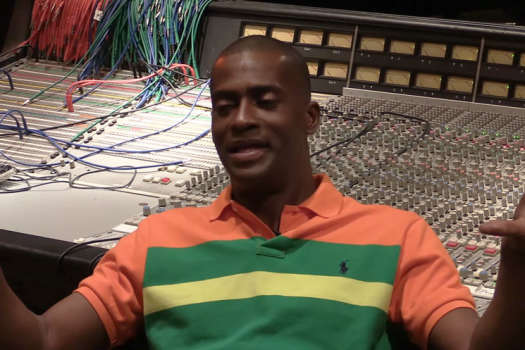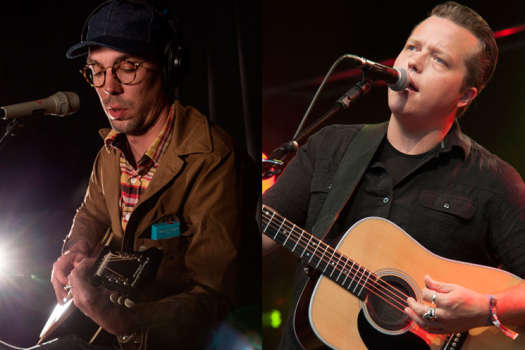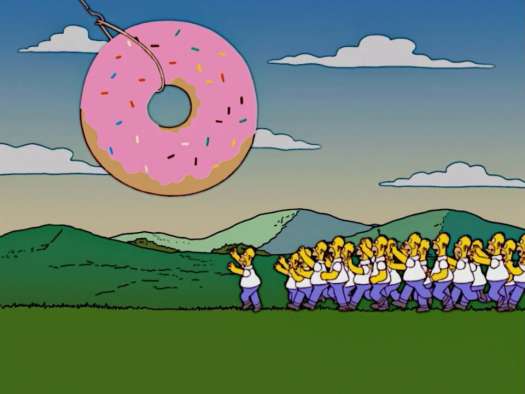Many people associate techno with raves, or define it as music made exclusively with technology. In harsher times, African-American dance fans have protested its noisy sound, and out of ignorance to its cultural origins, labeled it "Caucasian house." Such definitions discount the emotionality that drives this music's digital pulse as well as the beauty of its indefinable essence, which consistently pushes DJs and producers to pull away from a stale tradition.
Electro
The soul of techno can be found in the synthesised sounds of late 70s Kraftwerk; the Dusseldorf quartet's purely electronic orchestrations and visions of "man-machines" prove prophetic. In 1982, when Afrika Bambaataa and producer Arthur Baker borrow the riffs from "Trans Europe Express" and the bounce of "Numbers" for their seminal "Planet Rock," these sounds find a home on the dance floor. The Afro-Germanic hybrid of 808 drums, laser-tag synths and sci-fi fun gets called electro-funk, or electro for short, and sets the tone for b-boys and clubbers throughout the early 80s. The genre is short-lived, as break-dancing goes out of style and down-tempo forms of rap and R&B begin to dominate. The futuristic funk of electro flourishes in Detroit, where it becomes aggressively harder and renamed as techno-bass, or just bass, in the 90s.
Classics: Kraftwerk, Computer World (Elektra); Cybotron, Clear (Fantasy); Newcleus, Jam On It (Sunnyview)
Contemporary: Aux 88, Xeo-Genetic (Direct Beat); Drexciya, The Quest (Submerge); Various, Techno Bass: The Mission (Direct Beat)

(Photo: Jeff Mills)
Detroit
While Bambaataa and Baker take the credit for breaking in electro, Motorcity natives Juan Atkins and Richard Davies were sculpting a similar, but lyrically much more serious funk as Cybotron almost a year before the release of "Planet Rock." Cybotron eventually breaks up, but Atkins gets his due as a "godfather of techno" when he and his old school chums, Derrick May and Kevin Saunderson, begin mixing an alchemy of sounds from Detroit radio (obscure new wave, Italian disco and P-funk) with the tunes coming out of Chicago's early house scene. Atkins describes their defiantly minimal, energetic and electronic sound as techno, as based on Alvin Toffler's notion of the techno rebels who will "humanise" the hyper-developments of new technologies. Through its export and appropriation by world culture, these Detroit aesthetics have since been extrapolated into the areas of jazz (Innerzone Orchestra), politics (Underground Resistance) and abstract-expressionism (Plastikman), while countless others most of whom work outside of Detroit claim to preserve it through banal imitation.
Classics: Rhythim Is Rhythim, Innovator (Transmat); Suburban Knight, "The Art of Stalking" (Transmat); Underground Resistance, "Riot" (UR)
Contemporary: Jeff Mills, Lifelike (Axis); Aril Brikha, Deeparture In Time (Transmat), Various, Basic Channel (Basic Channel)

(Photo: Autechre)
Trance
Vulgarised by the excess of super-fast breakbeats, growling bass lines and attacks of white noise, techno loses its entrancing groove by the early 90s. Labels like R&S and Harthouse lead the way for a sound with hypnotic rhythms and sophisticated textures. Eventually, trance turns into an excuse to keep its mesmerising modes running on till infinity. Things get really ridiculous when Sven Vath and other DJs start holding parties on the beaches of Goa, India. Tracks begin to surface featuring badly-tuned samples of aum and other such mantras; the uninspired trend becomes known as goa trance.
Classics: Various, In Order To Dance (R&S); Various, Trance Europe Express (Volume); Various, Return To The Source (Positiva)
Contemporary: Sasha and John Digweed, Northern Exposure (Ultra); CJ Bolland, The 4th Sign (R&S), Bill Hamel, Nokturnal Mix Sessions (Topaz)

(Photo: C.J Rolland)
Intelligent
A brand of techno designed exclusively for home listening. The beats don't conform to a 4/4 rigor and the frequencies are just slightly heavier than ambient. Kind of like Björk without vocals. Recent experiments favour hip-hop breaks and drum & bass, but the patterns are always electronic and programmed.
Classics: Various, Artificial Intelligence (Warp); Black Dog, Bytes (Warp); Autechre, Incunabula (Warp)
Contemporary: u-ziq, Royal Astronomy (Astralwerks); David Kristian, Sawdust Sinedust Squaredust (Pandora); Plaid, Rest Proof Clockwork (Warp)
Electro
The soul of techno can be found in the synthesised sounds of late 70s Kraftwerk; the Dusseldorf quartet's purely electronic orchestrations and visions of "man-machines" prove prophetic. In 1982, when Afrika Bambaataa and producer Arthur Baker borrow the riffs from "Trans Europe Express" and the bounce of "Numbers" for their seminal "Planet Rock," these sounds find a home on the dance floor. The Afro-Germanic hybrid of 808 drums, laser-tag synths and sci-fi fun gets called electro-funk, or electro for short, and sets the tone for b-boys and clubbers throughout the early 80s. The genre is short-lived, as break-dancing goes out of style and down-tempo forms of rap and R&B begin to dominate. The futuristic funk of electro flourishes in Detroit, where it becomes aggressively harder and renamed as techno-bass, or just bass, in the 90s.
Classics: Kraftwerk, Computer World (Elektra); Cybotron, Clear (Fantasy); Newcleus, Jam On It (Sunnyview)
Contemporary: Aux 88, Xeo-Genetic (Direct Beat); Drexciya, The Quest (Submerge); Various, Techno Bass: The Mission (Direct Beat)

(Photo: Jeff Mills)
Detroit
While Bambaataa and Baker take the credit for breaking in electro, Motorcity natives Juan Atkins and Richard Davies were sculpting a similar, but lyrically much more serious funk as Cybotron almost a year before the release of "Planet Rock." Cybotron eventually breaks up, but Atkins gets his due as a "godfather of techno" when he and his old school chums, Derrick May and Kevin Saunderson, begin mixing an alchemy of sounds from Detroit radio (obscure new wave, Italian disco and P-funk) with the tunes coming out of Chicago's early house scene. Atkins describes their defiantly minimal, energetic and electronic sound as techno, as based on Alvin Toffler's notion of the techno rebels who will "humanise" the hyper-developments of new technologies. Through its export and appropriation by world culture, these Detroit aesthetics have since been extrapolated into the areas of jazz (Innerzone Orchestra), politics (Underground Resistance) and abstract-expressionism (Plastikman), while countless others most of whom work outside of Detroit claim to preserve it through banal imitation.
Classics: Rhythim Is Rhythim, Innovator (Transmat); Suburban Knight, "The Art of Stalking" (Transmat); Underground Resistance, "Riot" (UR)
Contemporary: Jeff Mills, Lifelike (Axis); Aril Brikha, Deeparture In Time (Transmat), Various, Basic Channel (Basic Channel)

(Photo: Autechre)
Trance
Vulgarised by the excess of super-fast breakbeats, growling bass lines and attacks of white noise, techno loses its entrancing groove by the early 90s. Labels like R&S and Harthouse lead the way for a sound with hypnotic rhythms and sophisticated textures. Eventually, trance turns into an excuse to keep its mesmerising modes running on till infinity. Things get really ridiculous when Sven Vath and other DJs start holding parties on the beaches of Goa, India. Tracks begin to surface featuring badly-tuned samples of aum and other such mantras; the uninspired trend becomes known as goa trance.
Classics: Various, In Order To Dance (R&S); Various, Trance Europe Express (Volume); Various, Return To The Source (Positiva)
Contemporary: Sasha and John Digweed, Northern Exposure (Ultra); CJ Bolland, The 4th Sign (R&S), Bill Hamel, Nokturnal Mix Sessions (Topaz)

(Photo: C.J Rolland)
Intelligent
A brand of techno designed exclusively for home listening. The beats don't conform to a 4/4 rigor and the frequencies are just slightly heavier than ambient. Kind of like Björk without vocals. Recent experiments favour hip-hop breaks and drum & bass, but the patterns are always electronic and programmed.
Classics: Various, Artificial Intelligence (Warp); Black Dog, Bytes (Warp); Autechre, Incunabula (Warp)
Contemporary: u-ziq, Royal Astronomy (Astralwerks); David Kristian, Sawdust Sinedust Squaredust (Pandora); Plaid, Rest Proof Clockwork (Warp)




